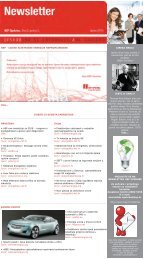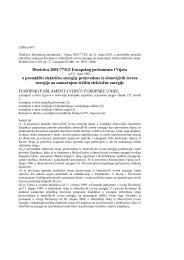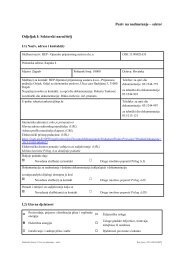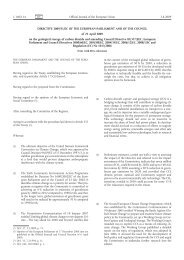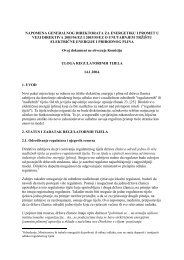Untitled
Untitled
Untitled
Create successful ePaper yourself
Turn your PDF publications into a flip-book with our unique Google optimized e-Paper software.
Tada je opÊe rjeπenje jednadæbe (22):Then the general solution of the equation (22) is:(26)OËita je jaka rasutost korijena p 1 i p 2 . Kada bi poanalogiji na razmatranje kao u poglavlju 3 formiralimatrice M, K i N, lako bismo zakljuËili da matricaK predstavlja singularnu matricu, jer u prvomstupcu sadræi umnoπke broja ep 1 T uk. Svi ti brojevisu za raËunalo praktiËki jednaki nuli zbog golemevrijednosti p 1 . Dakle, klasiËan analitiËki pristup uopÊem se sluËaju ne bi mogao provesti zbog singularnostimatrice K. U daljem dijelu razmatrat Êese numeriËki pristup rjeπavanja ovog problema.Meappleutim, i pri numeriËkom pristupu veoma jevaæno obratiti pozornost na izbor odgovarajuÊegnumeriËkog postupka zbog istaknute Ëinjenice dasu korijeni karakteristiËne jednadæbe jako rasuti ulijevom dijelu kompleksne ravnine. Jaka disperzijakorijena karakteristiËne jednadæbe definirazasebnu klasu diferencijalnih jednadæbi poznatihpod imenom krute diferencijalne jednadæbe (stiffdifferential equations). Naime, diskutabilna jeapsolutna stabilnost numeriËkih postupaka primijenjenihna ovu vrstu jednadæbi [17]. Nijedanod klasiËnih numeriËkih postupaka u eksplicitnojformi, bio jednokoraËni ili viπekoraËni tipa Eulera,Runge-Kuta, Adams-Moulton itd. pri standardnimkoracima integracije, ne osigurava apsolutnustabilnost postupka, πto dovodi do divergiranjarjeπenja u numeriËkom smislu (pogreπka k u k-tojiteraciji izaziva u k+1-oj iteraciji pogreπku k+1 > k ).Apsolutnu stabilnost osiguravaju jedino implicitninumeriËki postupci [17] i [18], mada i pri njihovojupotrebi treba biti jako oprezan. U konkretnomprimjeru upotrijebljeno je apsolutno stabilno implicitnotrapezno pravilo.Jednadæbe (18) do (22) Êe se napisati u prostorustanja uzimajuÊi da je vektor varijabli stanja:High dispersion of the roots p 1 and p 2 is evident.If matrices M, K and N are formed, analogically tothe discussion in Chapter 3, it could be easily concludedthat matrix K represents a singular matrixbecause it contains multiples of the number e p 1 T ukin the first column. All these numbers are practicallyequal to zero for a computer due to the enormousvalue of p 1 . Therefore, the classical analytical approachin a general case could not be implementeddue to the singularity of matrix K. The numericalapproach to the solution of this problem will bediscussed subsequently. However, with the numericalapproach it is very important to pay attentionto the selection of the suitable numerical approachprocedure due to the significant fact that the rootsof the characteristic equation are highly dispersedin the left part of the complex plain. The high rootdispersion of the characteristic equation defines aseparate class of differential equations known asstiff differential equations. The absolute stabilityof the numerical approaches applied in this typeof equation is disputable [17]. None of the classicalnumerical approaches in explicit form, whetherof the single-step or multistep Euler, Runge-Kutta,Adams-Moulton type etc. using standard integrationsteps, assures the absolute stability of the procedure,which leads to divergence of the solutions inthe numerical sense (error k in the k-th iterationcauses error k+1 > k in the k+1 iteration). Only implicitnumerical procedures guarantee absolute stability[17] and [18], although it is necessary to usethem very cautiously. In a concrete example, the absolutelystable implicit trapezoidal rule is applied.Equations (18) to (22) can be written in the statespace form where the state variable vector is:(27)Za nezasiÊeno podruËje gdje inaËe vrijedi:For the unsaturated region where the following otherwiseapplies:za / for(28)TokiÊ, A., UglešiÊ, I., NumeriËki proraËun niskofrekvencijskih..., Energija, god. 56(2007), br. 5., str. 584-607TokiÊ, A., UglešiÊ, I.,The Numerical Calculation of..., Energija, vol. 56(2007), No. 5, pp. 584-607598




